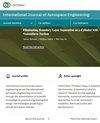Investigation and Validation of Mission Evaluation Models for Space Close-Range Inspection
IF 1.2
4区 工程技术
Q3 ENGINEERING, AEROSPACE
引用次数: 0
Abstract
Space close-range inspection can be used to carry out close-range observation and monitoring of targets for identifying the target’s types and working states, which is of great significance for space missions such as in-orbit services. The effectiveness evaluation of space inspection tasks will significantly affect the studies on the trajectory design, orbit motion control, and task termination conditions. However, the evaluation models in previous studies are too simple such as that they are usually without considering dynamic changes in the satellite orbit relative motion. Besides, these studies fail to build a comprehensive evaluation model for the whole inspection task process. In this paper, taking the most commonly used optical inspection as an example, the novel multifactor inspection task effectiveness evaluation models were investigated, including the constraint models of observation, the relative distance evaluation model, the effective observation time evaluation model, and the target observation angle evaluation model. These models solve the effectiveness evaluation problem for the complete process of an inspection task, which can support the design of inspection strategies and trajectories better by using the evaluation results. In addition, numerical simulations and 20 semiphysical experiments were carried out to validate the proposed evaluation models.太空近距离检查飞行任务评估模型的调查与验证
空间近距离巡检可用于对目标进行近距离观测和监测,以识别目标的类型和工作状态,对在轨服务等空间任务具有重要意义。空间检测任务的有效性评估将对轨迹设计、轨道运动控制和任务终止条件的研究产生重大影响。然而,以往研究中的评估模型过于简单,如通常不考虑卫星轨道相对运动的动态变化。此外,这些研究也未能针对整个检测任务过程建立全面的评估模型。本文以最常用的光学检测为例,研究了新型多因素检测任务有效性评价模型,包括观测约束模型、相对距离评价模型、有效观测时间评价模型和目标观测角度评价模型。这些模型解决了检测任务全过程的有效性评价问题,利用评价结果可以更好地支持检测策略和轨迹的设计。此外,还进行了数值模拟和 20 次半物理实验来验证所提出的评价模型。
本文章由计算机程序翻译,如有差异,请以英文原文为准。
求助全文
约1分钟内获得全文
求助全文
来源期刊

International Journal of Aerospace Engineering
ENGINEERING, AEROSPACE-
CiteScore
2.70
自引率
7.10%
发文量
195
审稿时长
22 weeks
期刊介绍:
International Journal of Aerospace Engineering aims to serve the international aerospace engineering community through dissemination of scientific knowledge on practical engineering and design methodologies pertaining to aircraft and space vehicles.
Original unpublished manuscripts are solicited on all areas of aerospace engineering including but not limited to:
-Mechanics of materials and structures-
Aerodynamics and fluid mechanics-
Dynamics and control-
Aeroacoustics-
Aeroelasticity-
Propulsion and combustion-
Avionics and systems-
Flight simulation and mechanics-
Unmanned air vehicles (UAVs).
Review articles on any of the above topics are also welcome.
 求助内容:
求助内容: 应助结果提醒方式:
应助结果提醒方式:


